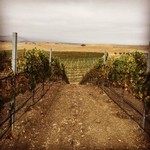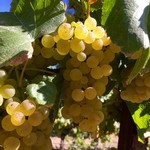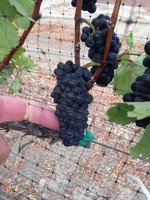
 Blog
Blog
Vintage
Vintage has a profound influence on the expression of wine even making the same wine from two different years taste noticeably different. Weather plays a key role including amount of sunshine, amount and timing of rain, wind, frost, hail, etc. But insects (in particular yellow-jackets), squirrels, deer and other fauna play a huge role. These factors influence each other and weave together to influence the overall Vintage and of course the enigmatic wine's express: what the French call Terroir.
For the Seal Beach Winery portfolio I will give a quick synopsis of some recent years.
2018
What I remember the most were inconsistencies. My Sangiovese from Estelle never ripened. The Pinot Noir from the Sta. Rita Hills seemed to take a very long time to move from Veraison to ripeness (as measured by Sugar levels or BRIX) but at the end went very fast. It rained toward the end of the growing season and many picked early. The Cabernet was more normal in timing not being Harvested until mid-October. And the Grenache came off last November 1st. In Winemaking we have a saying that difficult grapes (stressed) make great wine; and, I believe this will be a very good vintage.
2017
This was the year that everything started to revert back to normal or pre-draught times. It was a very standard year with a good winter rain and a little rain in the spring. It was a cool spring with some wind. There was lots of squirrel and insect damage. The Yellow-Jackets were so bad in Tierra Alta with the Tempranillo that had trouble walking the rows for fear of being stung to death. The squirrels at Estelle would run up one side of a row and strip it of grape clusters but spare the opposite site. There berries looked beaten up and ugly that year and I remember doing a great deal of sorting to eliminate the raisons and damaged fruit. But ugly grapes make fantastic wines. My Cabernet Clone 337 on Block 8 in Estelle suffered Berry Shot (small inconsistent clusters of grapes) and we did not harvest it. Good balance with tannin, alcohol and organoleptics are characteristic of this vintage. Overall, it was a very good year for wines with excellent Reds.
2016
Wet, wet and wet was the motif for this year. The rains came back and Harold the beginning of the end of the draught (it did not official end until the rains of 2018-2019). Overall Harvest was bountiful and a little early. It was warm in the summers to very hot. Most reds were harvested in September. I believe this will be an excellent year across the board for wine.
2015
This was a crazy year. For me, the vintage most effected by the draught. SBW yields were extremely small and everything was harvested on the early timeframe. I remember the very small berries on the cluster especially with the Pinot Noir. The Chardonnay at Harvest was golden with small raison like berries. The whites and the Pinot came off early in late August. The Harrison Clarke Syrahs were very early at first week in September. Cabernet and Grenache was Mid September to beginning of October. Last off was the Cabernet Clone 101 October 8, 2015. These are very concentrated, tannic and superior wines. The reds are amazing across the board. Drink now if you must but these wines will hold up to decades of aging.
2014
Good year for yields with fruit forward and early drinking wines. I think the tannin levels were very balanced yielding Cabernet and Pinot that is very drinkable early. I taste through this year and I think these wines are delicious and a bit showy with some star potential. I do not think these are wines that I would age because they are yummy right now; but I think the reds will hold up for a decade. There was very little rain and the growing season was early with whites harvested in August, Pinot in early September and Cabernet in early October. The Tempranillo from Tierra Alta was last off on October 7th, 2014.
2013
Although there was drought the crop levels were good to larger than normal. I would sum up 2013 by saying the wines were good but not exceptional. I did not think it was a bad year but no looking at how good 2015-2018 appear to be panning out makes me downgrade the overall vintage.
I thought it would be interesting to post the notes of a prominent viticulturist in Santa Ynez. Here's a brief synopsis of some past vintages from viticulturist Jeff Newton of Coastal Vineyard Care. Jeff manages SBW vineyards: Harrison-Clarke, Happy Canyon of Santa Barbara Vineyard, McGinley Vineyard, Tommy Town, Flower & Vine (Los Alisos) and Boa Vista to name a few.
2012
The 2012 season was a long sunny year, with normal rainfall amounts during the winter months, minimal frost and mild wind during bloom-time. Warm temperatures starting in mid-July and continuing through early October helped ripen the plentiful crop load. This also made harvest for both winemakers and grape growers more intense as many varieties ripened very close together.
2011
The 2011 season was challenging for growers. The spring time began with a damaging freeze which lasted for multiple days. Later cool, windy, and rainy weather at bloom further reduce the crop. The spring and summer weather was mild, creating high mildew and botrytis pressure. The growing season included unseasonable light rain events throughout the spring, summer and fall months. With the exception of a couple of light rain events, the harvest season was warm.
2010
2010 proved to be the coolest season in memory marked by reduced vine growth, low yields and delayed ripening. Both the spring and summer were unseasonable cool with the exception of a significant heat spike in late September followed by early rains during harvest season.
2009
Drought continued for the third year in 2009 leading to both low vigor and low yields. The spring and summer were mild and cool but a late September heat spike pushed the sugars up. The harvest season was challenging due to the October rains which were followed by 90 degree weather.
2008
2008 was a tough year with less than 10 inches of rainfall and a late April freeze that contributed to low yields. Summer was mild with the exception of a late August heat spike. This heat spike lead to an early harvest which was marked by an early October freeze occurring before the completion of harvest.
2007
2007 began with below average rainfall and cold winter temperatures, which in turn lead to late budbreak. Bloom time was cool, followed by an unpredictable summer with multiple heat spikes. The weather created a long hang time and an extended harvest season.
2006
2006 was the second year in a string of wet winters. The spring bloom time period was wet and windy as well. The summer continued to be very mild creating a long growing season with a later than usual harvest.
2005
An especially wet winter created large canopies and a heavy crop load. The mild and cool spring was followed by a hot early summer and finally settled into cool late summer and fall season. This created a long maturing process for the grapes, allowing the pH and sugars to be balanced.
2004
The 2004 season began beautifully with a warm spring which was followed by a mild summer. However a significant heat wave in September accelerated ripening and lead to an early harvest. Early October rains posed a late harvest threat.
2003
Early budbreak marked the beginning of the 2003 season, followed by unseasonable spring rains during bloom which impacted fruit set. The light crop was pushed to early maturity by a significant heat spike in August.
2002
The 2002 season began with average winter rainfall and a cool early spring. The cool weather continued during bloom leading to poor fruit set. Summer and fall continued to be cool, creating a long mild growing season allowing the light crop to hang and develop slowly.

